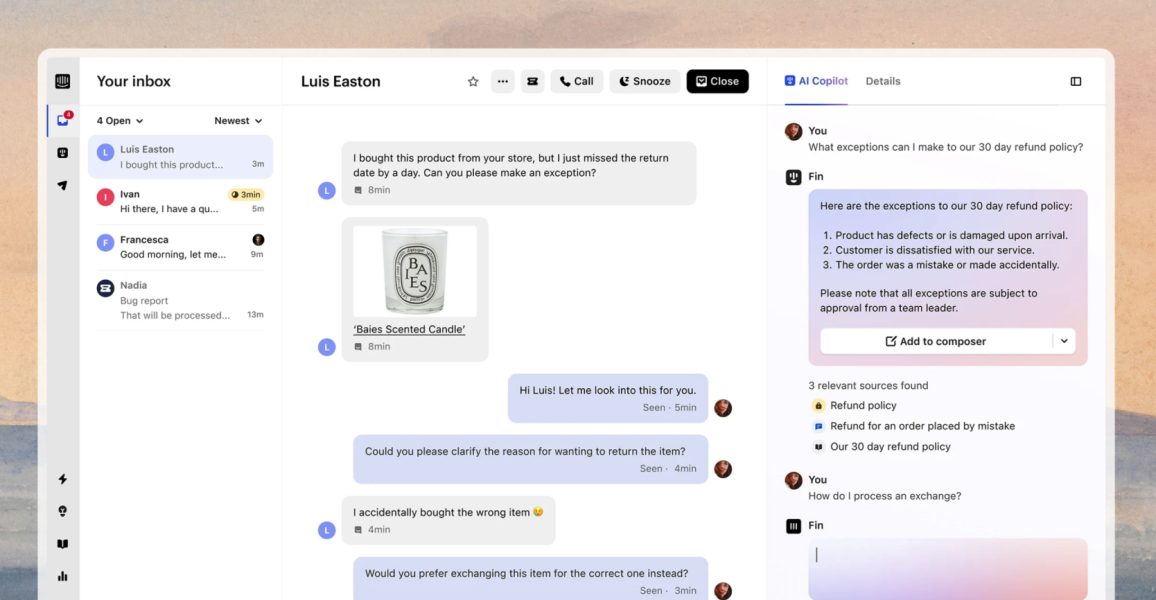Uitdaging
Als bedrijf met een geschiedenis van technologische innovatie was Intercom een van de eersten die AI en machine learning-tools gebruikte om zijn klantenserviceoplossingen te verbeteren. Maar met de lancering van ChatGPT in december 2022 zag Intercom een kans om de geavanceerde mogelijkheden van dit nieuwe model te gebruiken om zijn producten en businessmodel te veranderen. Door een samenwerking met OpenAI, de creator van ChatGPT, begonnen de ingenieurs van Intercom hun klantenserviceplatform helemaal opnieuw op te bouwen met GPT-tools. De eerste tool werd al drie maanden later gelanceerd en is sindsdien verder ontwikkeld met onder andere AI Agent en AI Copilot.
Terwijl Intercom zijn AI-tools aan het ontwikkelen was, besefte het bedrijf ook dat het een nieuw facturatiesysteem nodig had dat kon omgaan met het snelle en steeds veranderende karakter van AI-first-producten en facturatie. Klanten waren huiverig om te betalen voor geavanceerde technologie die misschien niet betrouwbaar was en wilden geen traditionele prijsstelling op basis van het aantal gebruikers voor producten zoals Fin. Ze wilden ook geen puur op gebruik gebaseerde prijzen, waardoor ze in feite twee keer zouden moeten betalen om bepaalde klantenserviceproblemen op te lossen: een keer voor het AI-product en nog een keer voor de mens die moest ingrijpen wanneer de AI het probleem niet zelf kon oplossen. Intercom had dus een facturatiesysteem nodig dat geschikt was voor een op resultaten gebaseerd prijsmodel, waarbij klanten alleen zouden betalen voor problemen die met succes waren opgelost.
In de loop der jaren had Intercom echter een facturatiesysteem voor klanten en een interne facturatie-interface ontwikkeld die was gekoppeld aan een extern platform voor het versturen van facturen voor klantabonnementen. Die ingewikkelde opzet maakte het voor Intercom lastig om nieuwe prijsmodellen te lanceren of abonnementvariabelen zoals kortingen en pro rata berekeningen te beheren.
Het systeem was ook gevoelig voor fouten door slechte integraties en gegevenssynchronisatie. Klantgerichte teams konden deze problemen niet oplossen omdat de API die het interne facturatieplatform met de tool voor het versturen van abonnementsfacturen verbond, niet makkelijk te gebruiken was en duidelijke documentatie ontbrak. Daardoor werden facturatiefouten een groot technisch probleem voor een team van zeven senior engineers, waarvan er één of twee elke week bezig waren met het oplossen van facturatiefouten en operationele problemen.
Intercom had een facturatieplatform nodig waarmee het makkelijker zou worden om nieuwe abonnementstarieven te ontwikkelen en tegelijkertijd optionele kosten, op gebruik gebaseerde vergoedingen en kortingen te ondersteunen, aangezien het bedrijf bestaande klanten migreerde naar zijn producten en prijsmodel. Dat platform moest ook efficiënte integratie bieden met verschillende andere systemen in de technologiearchitectuur van Intercom, zoals de boekhoudsoftware NetSuite, de belastingengine Avalara, het data lake AWS en de CRM-software (customer relationship management) van Salesforce.
Tweerichtingsintegratie met het CRM-systeem was vooral belangrijk omdat Intercom twee verkoopkanalen had: zelfbedieningsabonnementen voor kleinere bedrijven via de website van Intercom en een verkoopteam dat met grotere bedrijven werkte. Het creëren van een nieuw facturatieplatform was een kans om de abonnementsbeheerervaring voor beide kanalen te verenigen.
Het nieuwe facturatiesysteem moest vooral facturatiefouten verminderen en klantgerichte teams de mogelijkheid bieden om eventuele problemen zelf op te lossen, zonder dat ze daarvoor technici hoefden in te schakelen.
Oplossing
Intercom besloot om zijn interne en externe facturatiefuncties samen te voegen in Stripe Billing, dat precies de functies bood die Intercom nodig had om zijn nieuwe producten en prijsmodellen te ondersteunen. Billing bood de flexibiliteit om makkelijk integraties met andere belangrijke onderdelen van zijn technologiearchitectuur te maken en kon naadloos worden gekoppeld aan Stripe Payments, dat Intercom al gebruikte om creditcardbetalingen van abonnees te verwerken.
Intercom gebruikt ook Stripe's Optimized Checkout Suite. Dit omvat Stripe Elements, een set in te bouwen interfacecomponenten, om een soepel afrekenproces te creëren en toegang te bieden tot zeven betaalmethoden, waaronder bankoverschrijvingen, Apple Pay, Google Pay en Cash App Pay. Het bedrijf heeft ook Link toegevoegd, de digitale wallet van Stripe, waarmee klanten hun betaalgegevens eenmalig kunnen opslaan en deze gegevens vervolgens automatisch worden ingevuld bij volgende aankopen. AI-modellen die zijn ingebouwd in de Optimized Checkout Suite bepalen voor elke individuele aankoop welke betaalmethoden worden weergegeven en in welke volgorde, om het aantal abonnementen te maximaliseren.
Intercom zou ook de functies voor facturatie naar gebruik in Billing kunnen gebruiken om de resultaatgerichte prijsstrategie van Fin te ondersteunen, waarbij alleen opgeloste problemen worden gedefinieerd, gemeten en gefactureerd aan klanten.
Stripe's begrip van de belangrijkste kwesties die facturatiesystemen moeten beheren, waaronder meerdere prijsniveaus, pro rata berekeningen, kortingen, de mogelijkheid om nieuwe producten te testen en ondersteuning voor meerdere betaalmethoden, gaf Intercom het vertrouwen dat Billing zich zou ontwikkelen om de eigen roadmap van het bedrijf voor voortdurende groei en innovatie te ondersteunen. Voor zowel Intercom als Stripe zijn facturatiesystemen niet alleen een financiële functie, maar een belangrijk platform dat de productontwikkeling, kernprocessen, het businessmodel en de klantervaring van een bedrijf moet ondersteunen.
Voordat de migratie begon, voerde het Stripe-team voor zakelijke dienstverlening een gedetailleerde haalbaarheidsstudie uit om inzicht te krijgen in de huidige uitdagingen, bestaande technologiearchitectuur en toekomstige behoeften van Intercom. Gedurende drie maanden interviewde Stripe belangrijke stakeholders die met het facturatieplatform te maken hadden, waaronder productmanagers, facturatie-ingenieurs en leden van de boekhoud- en debiteurenafdelingen. Deze gesprekken hielpen ervoor te zorgen dat de migratie naar Billing aan de behoeften van alle partijen zou voldoen en zou kunnen worden geïntegreerd in de complexe interne systemen van Intercom.
De haalbaarheidsstudie resulteerde in een implementatieplan in drie fasen. Eerst zou Intercom zijn vernieuwde producten en prijsmodellen voor nieuwe klanten op Billing uitrollen. In de tweede fase zouden bestaande klanten naar de nieuwe producten en prijsmodellen worden gemigreerd. In de derde fase zou Intercom zijn resterende bestaande klanten naar Billing migreren, maar hen op de oude prijsmodellen houden totdat ze naar nieuwe producten zouden upgraden.
Om de eerste fase van het project te beheren, coördineerde het Stripe-team voor zakelijke dienstverlening een implementatieteam met experts in de VS, Dublin en Londen, die nauw samenwerkten met technische, financiële en operationele stakeholders van Intercom om een nieuwe facturatiearchitectuur uit te stippelen. De nieuwe prijsmodellen van Intercom omvatten drie abonnementsniveaus voor bedrijven van verschillende grootte, met prijzen per gebruiker die het niveau van de functies in elk niveau weerspiegelen. Die prijzen omvatten op gebruik gebaseerde kosten voor bepaalde functies en kanalen, evenals kosten voor optionele add-on-services, die allemaal worden verrekend in de maandelijkse factuur van de klant.
Het professionele serviceteam van Stripe bleef tijdens de hele implementatie samenwerken met het team van Intercom en deelde technische en operationele best practices om een succesvolle lancering te garanderen. De teams stelden nieuwe producten, prijzen en facturatieregels op en koppelden Billing aan andere systemen in de technologiearchitectuur van Intercom met behulp van een combinatie van vooraf gebouwde connectoren en aangepaste integraties. Het implementatieteam koppelde Billing bijvoorbeeld aan de Avalara-belastingengine van Intercom met behulp van de vooraf gebouwde connector AvaTax for Stripe, die luistert naar webhook-events van Stripe Invoicing om belastingen te berekenen en af te dragen op basis van het land waar de factuur wordt uitgegeven en het land van de klant. Om Billing te koppelen aan Salesforce, gebruikte Intercom de Stripe API om een aangepaste integratielaag te bouwen.
Als Stripe-gebruikers kreeg Intercom ook toegang tot een Stripe-dashboard, dat gedetailleerd inzicht gaf in de abonnementsniveaus van klanten, factuurgegevens en betalingsstatus. Voorafgaand aan de lancering van de eerste fase van het nieuwe facturatieplatform gaf het Stripe-implementatieteam een tutorial aan het facturatie team van Intercom, waarin ze lieten zien hoe ze het dashboard konden gebruiken om facturatieproblemen te identificeren en op verzoeken van klanten te reageren.
Resultaten
Vijf maanden om nieuwe prijzen te introduceren voor nieuwe klanten
Dankzij een gedetailleerde planning en de flexibiliteit van de integratiemogelijkheden met Billing heeft Intercom de eerste fase van de migratie binnen vijf maanden afgerond, wat samenviel met de lancering van de nieuwe tariefplannen in november 2023. In oktober 2025 waren alle abonnees en inkomsten gemigreerd naar Stripe.
"Door Stripe Billing beetje bij beetje te gebruiken, konden we onze facturatiesystemen sneller verbeteren zonder dat onze bestaande activiteiten in de war raakten", zegt James Treanor, senior product engineer bij Intercom. "Omdat we vertrouwen en kennis hebben opgebouwd in Stripe Billing, konden we klanten geleidelijk naar het nieuwe systeem overzetten en zo deze snelle aanpak met weinig risico's blijven volgen."
Drie maanden om facturatie naar gebruik te integreren
Ondanks het geavanceerde resultaatgerichte facturatiemodel van Fin, kostte het het Intercom-team slechts drie maanden om facturatie naar gebruik volledig te integreren. "facturatie naar gebruik maakt het veel makkelijker om nieuwe prijsmodellen te introduceren", aldus Dave Lynch, VP Engineering bij Intercom. "We hoeven alleen maar gebeurtenissen te activeren en Stripe doet de rest."
Nieuw facturatieplatform ondersteunt flexibele prijsmodellen voor abonnementen
Door over te stappen op Billing kon Intercom een simpel, op licenties gebaseerd facturatiemodel invoeren, waarbij ze voor bepaalde klanten kortingen op afzonderlijke factuurregels konden geven – iets wat ze met hun vorige provider niet konden doen. "Met Stripe zijn kortingen flexibel", zegt Lynch. "Ons team kon zich makkelijk aanpassen als dat nodig was."
Daarnaast heeft Intercom Billing gebruikt om zijn prijsstelling te vernieuwen. "Door ons nieuwe prijsmodel met Stripe te introduceren, konden we snel en met zoveel flexibiliteit als we nodig hadden, onze prijsstelling aanpassen", aldus Treanor.
Door alles op één platform te zetten, hebben onze technici meer tijd om aan nieuwe producten te werken.
Door de derde partij tussen de facturatie-engine en betalingen weg te halen, denkt Intercom dat er veel minder facturatiefouten zullen zijn. "Stripe regelt het bijhouden van het gebruik voor ons", zegt Lynch. "Dat maakt het veel makkelijker dan hoe we het vroeger deden, en zo kunnen we meer tijd besteden aan het direct leveren van waarde."
Bovendien is er geen black box API meer die deze systemen met elkaar verbindt, waardoor klantgerichte teams eenvoudig kunnen inloggen op Stripe en de meeste problemen kunnen oplossen zonder dat ze vragen hoeven door te geven aan het engineeringteam. De senior engineers van het bedrijf zitten niet meer vast aan routinewerk, waardoor ze zich kunnen richten op het ontwikkelen van nieuwe producten en het verfijnen van de belangrijkste AI-aangedreven klantenservicetools van Intercom.
"Stripe Billing is aanzienlijk vriendelijker voor de developer dan onze oude setup", zegt Kevin McNally, senior machine learning engineer bij Intercom. "Dankzij de betere documentatie en intuïtievere kernconcepten voor abonnementsbeheer is het voor ons team veel makkelijker om stapsgewijze veranderingen door te voeren."
Door over te stappen op Stripe heeft Intercom zijn facturatiestrategie afgestemd op zijn product- en klantervaringsdoelen: het leveren van een ervaring van wereldklasse die de nadruk legt op eenvoud en prioriteit geeft aan voortdurende verbetering in plaats van het handhaven van de status quo.
Ons doel is om eenvoudige, transparante en flexibele prijzen te bieden waarbij onze klanten centraal staan. We hebben voor Stripe gekozen, niet alleen vanwege de verschillende prijsmodellen, maar ook vanwege hun super hoge standaard voor kwaliteit en hun vermogen om snel te handelen. Dat is precies de ervaring die we onze klanten willen bieden.

